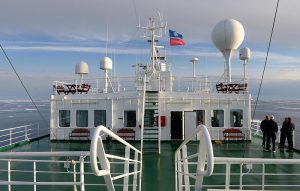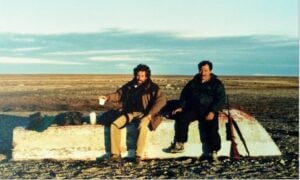
History
2014 Victoria Strait Expedition
This year's search is about much more than underwater archaeology. The Victoria Strait Expedition will contribute to northern science and communities.
- 1205 words
- 5 minutes
This article is over 5 years old and may contain outdated information.
History

August 16, 2014, 21:00 Mountain Standard Time
While the Victoria Strait Expedition won’t begin for us for another week or so, the crew of the Canadian Coast Guard ship Sir Wilfrid Laurier is already engaged in our annual Arctic summer work program.
We changed crews in Kugluktuk on August 12. The previous crew, who earned their flights home to Victoria after leaving port nearly six weeks and 5,072 nautical miles ago, assisted science specialists who embarked at Dutch Harbour, Alaska and conducted oceanographic work in the Bering and Chukchi seas.
The first sight of sea ice during that leg appeared on July 21 near Wainwright, Alaska, and continued into the Alaskan North Slope. Upon finishing their work, the science staff disembarked at Barrow, Alaska.
As part of more typical operations, this crew also provided icebreaking services and an escort for a Canadian vessel into the Beaufort Sea. Once in Canadian waters, the Laurier serviced 56 navigation aids that directly support safe shipping through Arctic waters.
On August 6th, six staff members from the Canadian Hydrographic Service (a branch of Fisheries and Oceans Canada) came aboard and set to work. It’s common for us to work closely with these surveying and charting experts as they share our mandate of marine safety. Their survey launches, CSL Gannet and CSL Kinglett (specialized vessels for conducting hydrographic survey work carrying a lot of cutting edge technology), were shipped from Victoria aboard the Laurier. The hydrographers have been busy conducting surveys in Dolphin and Union Strait, Coronation Gulf and are now surveying eastward in Queen Maud Gulf to widen the existing shipping corridor. In addition, the Canadian Hydrographic Service has equipped the Laurier and the Royal Canadian Navy ship HMCS Kingston with multibeam sonars for the first time, which will contribute to our ability to surveying the Arctic.
Once the current crew conducted our required safety drills, we continued transiting eastward. We are continuing to service navigation aids, and will be establishing navigation buoys in Cambridge Bay and Simpson Straits.
Our team is also growing as we head eastward, and our stop in Cambridge Bay on August 16 included picking up terrestrial archeologists Dr. Doug Stenton of the Government of Nunavut and Dr. Robert Park of the University of Waterloo. Our stop also included a rendezvous with the Arctic Research Foundation’s vessel Martin Bergmann to transfer cargo that we carried up for them to assist in their upcoming research activities. The Bergmann is also in preparation mode, with a few other partners aboard, including Parks Canada and Royal Canadian Navy staff.
There are few slow days on our ship, and there is much to do in such a short field season. In only a few weeks all vessels and partners of the Victoria Strait Expedition will be fully operational. There is still quite a bit of ice in Victoria Strait at the moment. In fact, one of the channels near the survey area is known as Icebreaker Channel — a reminder to all of us that work up here remains a challenge and should not be taken lightly. It is the Arctic after all.
Are you passionate about Canadian geography?
You can support Canadian Geographic in 3 ways:

History
This year's search is about much more than underwater archaeology. The Victoria Strait Expedition will contribute to northern science and communities.

History
First official day of the 2014 search for Sir John Franklin’s lost ships

History
Arctic historian Ken McGoogan takes an in-depth, contemporary perspective on the legacy of Sir John Franklin, offering a new explanation of the famous Northern mystery

People & Culture
On April 12, Franklin enthusiasts had a rare opportunity to come together in the same room as The Royal Canadian Geographical Society presented their 2016 Can Geo Talks